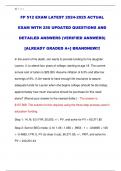1|Page
FP 512 EXAM LATEST 2024-2025 ACTUAL
EXAM WITH 250 UPDATED QUESTIONS AND
DETAILED ANSWERS (VERIFIED ANSWERS)
[ALREADY GRADED A+] BRANDNEW!!!
In the event of his death, Jim wants to provide funding for his daughter
Lauren, 4, to attend four years of college, starting at age 18. The current
annual cost of tuition is $25,000. Assume inflation of 6.5% and after-tax
earnings of 6%. If Jim wants to have enough life insurance to assure
adequate funds for Lauren when she begins college (should he die today),
approximately how much insurance should he purchase for this need
alone? (Round your answer to the nearest dollar.) - The answer is
$107,568. The solution to this requires using the three-step process used in
education funding.
Step 1: 14, N; 6.5 I/YR; 25,000, +/-, PV, and solve for FV = 60,371.85
Step 2: Set for BEG mode; 4, N; 1..065 = .9953 - 1 = -.004695 × 100
= -0.4695, I/YR; 0, FV (to clear it out), 60,371.85, +/-, PMT, and solve for
PV = 243,201.44
,2|Page
Step 3: 14, N; 6, I/YR; 243,201.44, FV, 0, PMT (to clear it out), and solve
for PV = 107,568
LO 3.4.1
Which of the following life insurance riders allows for additional term life
coverage on a cash value policy for the named insured? - A term rider
jeff owns a life insurance policy on his own life. The policy is not a modified
endowment contract (MEC). His basis in the policy is $10,000. This year,
he pays premiums of $1,000 on the policy, receives dividends of $300 in
cash, and takes a withdrawal of $5,000. In addition, the cash value of the
policy increases by $2,000. Which of the following statements regarding the
income tax consequences of this policy is CORRECT?
The premiums of $1,000 are tax deductible.
The $2,000 increase in cash value is excluded from gross income.
The dividends of $300 are included in gross income.
The withdrawal of $5,000 is included in gross income. - The $2,000
increase in cash value is excluded from gross income
,3|Page
Whole life insurance nonforfeiture options allow a policyowner to
surrender a whole life insurance policy and receive the net cash value
(cash value less any applicable surrender charges and/or outstanding
policy loans).
stop paying premiums on a whole life insurance policy and exchange the
net cash value for a reduced paid-up single-premium permanent life
insurance policy.
stop paying premiums on a whole life insurance policy and use the net
cash value as a single premium to purchase a paid-up term life insurance
policy with a face amount equal to the face amount of the original policy for
a specified period. - I, II, and III
Carolyn was the beneficiary of her spouse's life insurance policy with a face
amount of $1,000,000. She elected the single life annuity settlement option.
The settlement option will pay her $4,500 per month, and her life
expectancy is 30 years. How much of each monthly payment is taxable? -
he answer is $1,722 (rounded). The total amount Carolyn will receive from
the settlement option is $1,620,000 ($4,500 × 360). Her tax basis is
, 4|Page
$1,000,000, so her exclusion ratio is 0.6173 ($1,000,000 ÷ $1,620,000).
Therefore, $2,777.85 of each payment is excluded from gross income
($4,500 × 0.6173), and the remainder ($1,722.15) is taxable. In addition,
the taxable income may be subject to the 3.8% Medicare contribution tax.
LO 3.2.5
A life insurance contract with low fixed premiums during the first three to
five years and higher fixed premiums for the remainder of the policy period
is called - a modified premium whole life policy.
Which of the following term life insurance policies is designed to protect the
insured's mortgage? - Decreasing term life insurance
Frank and Julie recently purchased an annuity to help provide them with
retirement income. They will pay the premiums with after-tax dollars, and
they will begin receiving income payments from the annuity at age 65. After
analyzing these facts, which type of annuity did Frank and Julie purchase?
- Deferred nonqualified annuity




